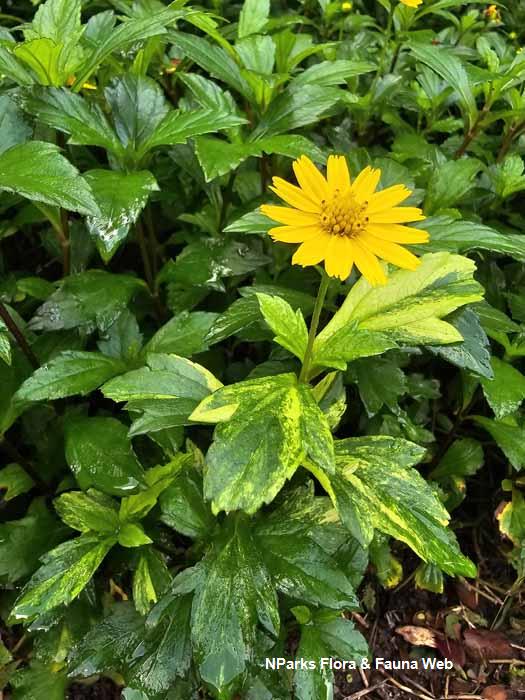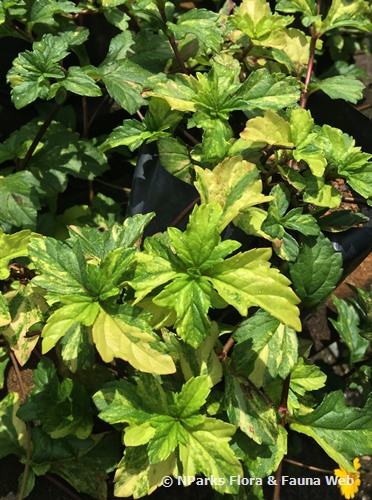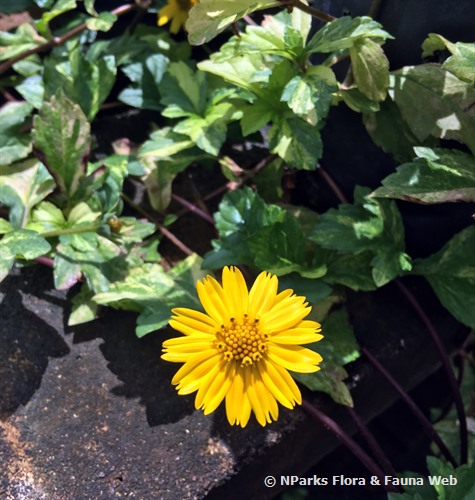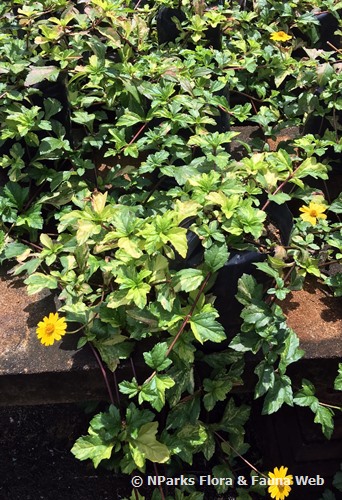
Back
Sphagneticola trilobata (Variegated)
| Family Name: | Asteraceae (Compositae) |
Sphagneticola trilobata (Variegated) is a fast-growing creeper with bright yellow daisy-like flowers and glossy variegated leaves. Grows best under full sun, this variegated version of Yellow Creeping Daisy can tolerate a wide range of soil conditions such as poor infertile soils and shallow media.
Name
Classifications and Characteristics
| Plant Division | Angiosperms (Flowering Seed Plants) (Dicotyledon) |
|---|---|
| Plant Growth Form | Creeper, Herbaceous Plant |
| Lifespan (in Singapore) | Perennial |
| Mode of Nutrition | Autotrophic |
| Plant Shape | Shrubby, Irregular |
| Maximum Height | 0.2 m to 0.7 m |
| Maximum Plant Spread / Crown Width | 2 m |
Biogeography
| Native Habitat | Terrestrial |
|---|---|
| Preferred Climate Zone | Tropical |
| Local Conservation Status | Of Uncertain Origin |
Description and Ethnobotany
| Growth Form | A herbaceous and perennial creeper which forms dense mat over ground. |
|---|---|
| Foliage | Leaves are glossy green, variegated with yellow. Leaf blade has serrated margins. |
| Flowers | Flowers are borne on solitary or branched inflorescence, ray florets and disc florets are yellow. |
| Cultivation | The plant prefers full sun in order to flower, but can tolerate shady condition. Adaptable to wide range of soil types, including nutrient poor sand, saline soils, swampy or waterlogged areas and bare limestones. Tolerant of dry periods. Prune plant regularly as plants are fast grower, may smother nearby groundcovers. Easily propagated via stem cuttings and stolons. |
| Etymology | Genus sphagneticola means sphagnum dweller, a possible reference to the plant being able to survive in waterlogged or flooded sites. Specific epithet trilobata describes the 3-lobed leaves. |
Landscaping Features
| Landscaping | Suitable for growing for general purpose, as ground cover or flowerbed border for its ornamental flowers and variegated leaves. |
|---|---|
| Desirable Plant Features | Ornamental Flowers, Ornamental Foliage |
| Landscape Uses | General, Parks & Gardens, Small Gardens, Groundcover, Container Planting |
| Thematic Landscaping | Golden Garden |
| Usage Hazard - Cons | Toxic Upon Ingestion |
Fauna, Pollination and Dispersal
| Fauna Pollination Dispersal Associated Fauna | Butterfly-Attracting |
|---|---|
| Pollination Method(s) | Biotic (Fauna) |
Plant Care and Propagation
| Light Preference | Full Sun, Semi-Shade |
|---|---|
| Water Preference | Moderate Water |
| Plant Growth Rate | Fast |
| Rootzone Tolerance | Drought Tolerant, Waterlogged Soils, Well-Drained Soils, Saline Soils / Salt Spray, Poor Infertile Soils, Fertile Loamy Soils, Acidic (low pH) Soils, Alkaline high pH Soils, Shallow Media, Disease / Pest Resistant, Easy to Grow |
| Maintenance Requirements | Moderate |
| Propagation Method | Stem Cutting, Stolon / Runner |
Foliar
| Foliage Retention | Evergreen |
|---|---|
| Mature Foliage Colour(s) | Green, Yellow / Golden |
| Mature Foliage Texture(s) | Glossy / Shiny |
| Prominent Young Flush Colour(s) | Green, Yellow / Golden |
| Young Flush Texture(s) | Glossy / Shiny |
| Foliar Type | Simple / Unifoliate |
| Foliar Arrangement Along Stem | Opposite |
| Foliar Attachment to Stem | Petiolate |
| Foliar Shape(s) | Non-Palm Foliage (Oval) |
| Foliar Venation | Pinnate / Net |
| Foliar Margin | Serrate / Toothed, Pinnately Lobed / Pinnatifid |
| Foliar Apex - Tip | Acute |
| Foliar Base | Cuneate |
Non - Foliar and Storage
| Stem Type & Modification | Runner / Stolon |
|---|---|
| Root Type | Underground |
Floral (Angiosperm)
| Flower & Plant Sexuality | Bisexual Flowers |
| Flower Colour(s) | Yellow / Golden |
|---|---|
| Flower Texture(s) | Smooth |
| Flower Grouping | Cluster / Inflorescence |
| Flower Location | Terminal |
| Flower Symmetry | Radial |
| Inflorescence Type | Compound Head / Capitulum |
| Flowering Period | Free-Flowering |
Image Repository
Others
| Master ID | 33596 |
|---|---|
| Species ID | 8010 |
| Flora Disclaimer | The information in this website has been compiled from reliable sources, such as reference works on medicinal plants. It is not a substitute for medical advice or treatment and NParks does not purport to provide any medical advice. Readers should always consult his/her physician before using or consuming a plant for medicinal purposes. |




